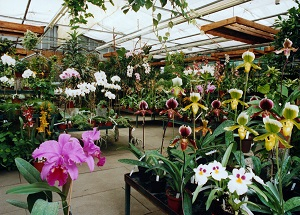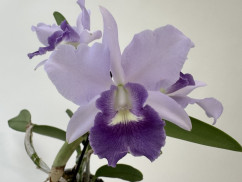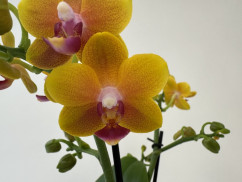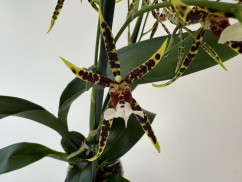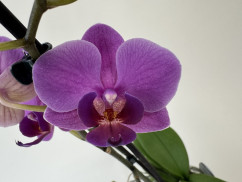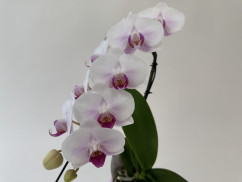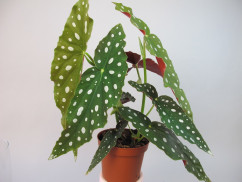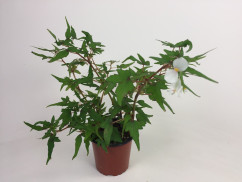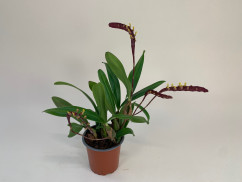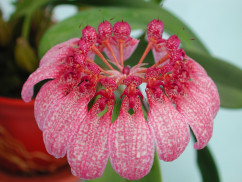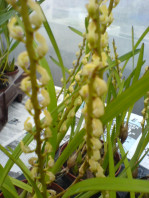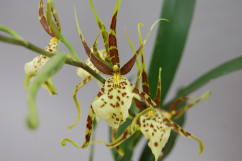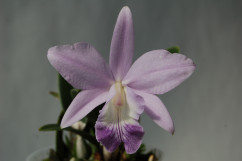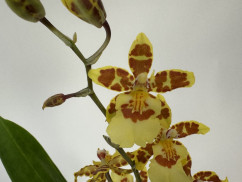Orchids Care Guide from the professional - The most important care tips
1. Orchid location - What is the best location for orchids?
Orchids thrive on every windowsill in the living area, preferably with east, south or west orientation.
2. Orchids are children of the light, so they tolerate a lot of brightness.
From April to the end of August, the direct sunlight can be too hot and too bright on the windowsill, so that leaves can burn - then lightly shading with curtains, blinds or paper.
3. Orchids flower every year and rejoice you, when they are poured moderately.
That is 1 to a maximum of 2 times a week from the top vigorously and penetrating pour rainwater or boiled water. No foot bath: please drain excess water!
4. Orchids are satisfied with little food.
Use our Orchid or Tillandsium fertilizer 1 to 2 times per month according to instructions and the plants will thank you. Do not use flower fertilizer.
5. Orchids are easy to care for as hardly any other plants.
They are only repotted every 2 to 3 years. Bring us your plants to repot (preferably in the spring / summer calendar) or use our orchid soil to do it yourself.
Fertilize orchids properly
How often do orchids have to be fertilized?
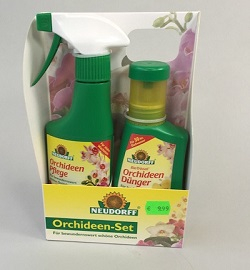 The nutrient supply in the pot of a houseplant is limited, so they must be fertilized regularly. However, it is hardly possible to ensure a supply of nutrients as in nature, because nutrients are constantly available in rainwater, in fog and in organic soil, albeit in extremely low concentrations. But this is not a problem for orchids, because they are "weak-eaters", that is, they get by with very low nutrient doses. The sensitive roots are therefore quickly damaged if you fertilize too generously.
The nutrient supply in the pot of a houseplant is limited, so they must be fertilized regularly. However, it is hardly possible to ensure a supply of nutrients as in nature, because nutrients are constantly available in rainwater, in fog and in organic soil, albeit in extremely low concentrations. But this is not a problem for orchids, because they are "weak-eaters", that is, they get by with very low nutrient doses. The sensitive roots are therefore quickly damaged if you fertilize too generously.
It is a good guideline to add liquid fertilizer to the irrigation water every two to three weeks. Under no circumstances should the dosage recommended by the manufacturer be exceeded! When too much fertilizer is administered, salts deposit as whitish crystals on substrate and roots. In the worst case, burns of the aerial roots can be the result. However, this can be avoided by always slightly underdosing the fertilizer.
When should be fertilized?
The nutrients need orchids to form new leaves, roots, buds and flowers. Therefore, especially in the spring periodically, so every 2 weeks, be fertilized to support the formation of new formation. In winter orchids take a break and their metabolism requires less nutrients. Now they only need to be fertilized rarely or not at all.
Even freshly transplanted plants need no additional nutrients for 4 to 6 weeks.
What should be fertilized?
Orchid fertilizer is best used to provide optimum care for orchids, as it has an ideal composition that closely matches the nutrient requirements of orchids, is low in salt and well tolerated.
But not only the nutritional needs, but also the special orchid substrate determine which fertilizer is best suited. In the coarse and slightly moist substrate, fertilizer sticks dissolve poorly and spread only unevenly.
Also, organic fertilizer is not suitable, because in this case, the nutrients must first be released by microorganisms to be available in plant-available form. The biotic activity of the orchid substrate is too low to accomplish this.
The nutrients are best distributed from liquid fertilizer, which is added to the irrigation water. If no orchid fertilizer is available, till fertilizer can also be used.
Water orchids - but not too much!
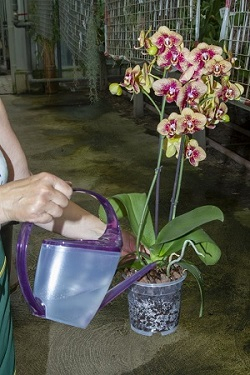
How much water an orchid needs depends on the species.
Those with bulbs or leather-like strong leaves are experts in storing water and tolerate it to be dry for a short time. Pouring it vigorously once a week is quite sufficient. Everyone else, including the lady's slipper, for example, loves constant hydration and needs fresh irrigation water once or twice a week.
he basic rules are:
Orchids do not like wet feet, so waterlogging must be avoided.
A good guideline is to water once a week.
If the orchid is budding or blooming, and in spring when orchid growth is in full swing, it will consume a little more water. In winter it should be poured accordingly a little more economical
What water to pour?
It is best to use room-warm rainwater, because it has a low salt content and pH, and soft tap water is also well suited.
When and how to pour?
But when it comes to watering, too, is the time: Who waters his plant in the morning, gives her the opportunity to dry during the day and rot does not stand a chance. There are different ways to water an orchid: watering with a hose, shower head or watering can is just as good as putting the plant in a water bath for a few seconds.
visit our Orchids in our Store
Repot orchids
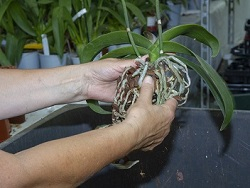 Orchids regularly need to have fresh substrate and a large enough pot to keep them healthy and beautiful for a long time.
Orchids regularly need to have fresh substrate and a large enough pot to keep them healthy and beautiful for a long time.
How often repot?
At least every two years, it is time to repot an orchid, as the substrate decomposes over time and damages the roots.
Why is repot necessary?
The substrate thickens, leaving the root poorly ventilated and permanently moist. At the same time, mineral salts are released by composting processes, which are harmful in too high an amount. In addition, the plant can not evolve if the pot is too small.
This is the case at the latest when the plant grows beyond the pot edge.
When is the best time to repot?
The increasing light radiation makes the spring at the optimal time to repot, because neutering and root growth are now particularly well stimulated.
Only in exceptional cases, when a plant is in very bad condition, may it be repotted in winter.
Instructions: Proper repot of orchids
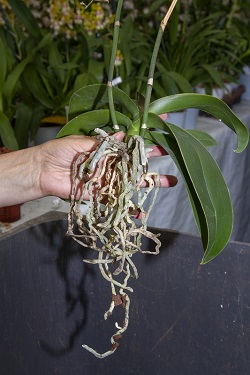
|
Step 1 - PreparationWhen working with orchids, it is important to always use clean, as sterile a tool as possible. The pots should best be new and knives carefully cleaned. |
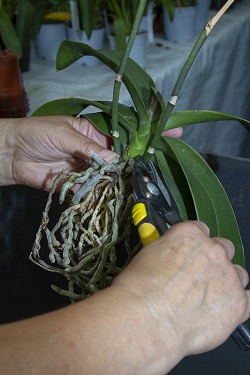
|
Step 2 - Remove inflorescences and remove old substratenFirst cut the inflorescences back completely and free the root system from the old earth. This should no longer, not mixed, reused for orchid culture. |
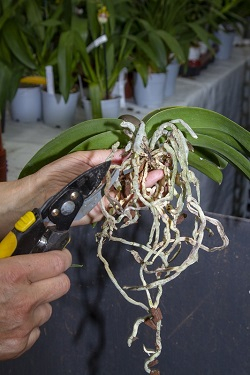
|
Step 3 - Cut off rotten or dried rootsCut off rotten or withered roots (recognizable by their soft or paper-like structure) and leave the plant on a newspaper pad for 24 hours to allow the interfaces to scarify. |
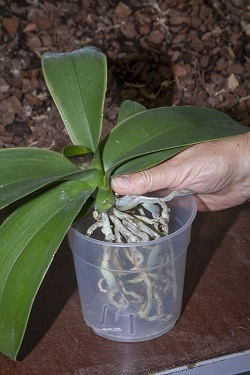
|
Step 4 – Choose the new potThe new pot should only be one size bigger than the old one, with too much space you do not do your orchid a favor. It is best to choose a plastic pot because orchids in clay pots need to be poured too often. The aerial roots of the orchid now fit into the larger pot and, after some time in the substrate, transform into erdwohnende roots. After a long time, however, it can happen that the plant has formed many long aerial roots. If these are squeezed into the pot, it damages the roots, they can be confidently cut away. |
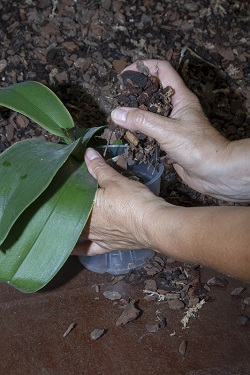 |
Step 5 - Fill with fresh substrateNow the root spaces are filled up with fresh substrate until just below the edge of the pot, spread by lightly tapping and pressing and lightly cast. Since the quality of the planting material is crucial for the health of the orchid, you should always buy this from the orchid specialist. |
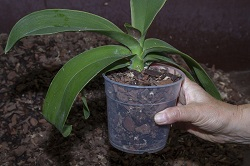
|
Step 6 – The following weeksIn order for the plant to emerge stronger from the repotting, it is recommended to first pour sparingly and to fertilize lightly until new roots form. The plant feels particularly well in the following weeks in a warm, shady place. |
Find the right Pot in our Store
Cutting orchids properly
How often you have to cut an orchid depends on the species in the first place. Usually, however, they rarely have to be cut back.
Flowering cut in single and multi-spotted species
If one-of-a-kind species such as Dendrobium or Lady's Slipper have faded, that is, if all the flowers have fallen off by themselves, the flower stem can be cut off directly at the base. There are no further flowers to be expected here.
Multi-shoot species, such as Phlaenopsis, may form new flowers on a decayed stalk after some time. To do this, the faded stalk must be cut off over the second or third eye. But it takes patience: 3-5 months it may take until the plant appears in new flower splendor. Such remounting can work up to three times with the same stalk.
Flowering cutback on flowering plants
Well-groomed orchids bloom year after year. Their flower stems should usually be cut back only when they are brown and dry. If only a small side shoot of a stem turns brown, only this and not the whole green stem should be cut off.
Exceptions are sparse, flowering plants that produce just one or two flowers on a stem. In this case, it is best to cut off the still green shoot, so that a new stronger flowering stalk can regrow.
Of course, stems that are in full bloom, can be cut off and given away as cut flowers. They work best if they are cut off at the bottom with a long oblique cut and the water is changed frequently, ie every three days at the latest.
Root pruning
It is advisable to look at the roots every 2 to 3 years when repotting and to remove soft rotten or dried roots.
Cutting off aerial roots or healthy green roots can weaken the orchid. Even if they look surplus or unsightly, you should be cautious here and cut back only if the orchid has formed many aerial roots.
Leaf pruning
Over the years, the bottom leaves of each plant become senescent, or old, and appear dry and pale, and finally yellow and shriveled. As long as they are still stuck, the plant extracts biomolecules from the leaf to recycle them and use their building blocks to form new leaves.
When this process is complete, the plant repels the leaf. You should not remove it unless it is easy to pluck it off with your hand. Only in sick plants, a pruning of green leaves may be made to prevent them from spreading to germs in the plant.
Leaves should never be partially cut off, as the interfaces are a portal of entry for germs.
The right tool
Basically, it is important to use very sharp and clean, best sterile knives when cutting, as the tool can otherwise introduce pathogens into the tissue via the cutting points.
To do this, pull the blade briefly through a candle flame immediately before use, hold it in boiling water or wipe it with methylated spirits.
Orchid substrate
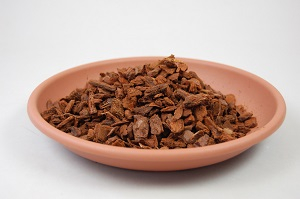 Unlike other houseplants, we do not cultivate orchids in potting soil but in a special orchid substrate. But why?
Unlike other houseplants, we do not cultivate orchids in potting soil but in a special orchid substrate. But why?
Orchids, at least epiphytische, grow in their tropical homeland not in the earth, but on trees or even rock. As a result, their roots are specialized in getting enough water and nutrients from the humid air, the rainwater and the organic material of the subsoil.
The most important property of orchid substrate is thus its rough structure. This makes it permeable to air, irrigation water runs off immediately and very little moisture is stored. Ultimately, the substrate contains the amount of water that is available to an orchid in the jungle in the humidity and the surface of the tree bark. If the roots were in constant contact with damp soil, they would quickly rot.
But even semi-terrestrial orchids, which grow on the ground and also have aerial aerial roots, need an air-permeable substrate. For phalaenopsis, a loose material is also important because they can even use photosynthesis with their roots if they have light contact.
Composition
There are different organic substrate components, ie components of natural origin, such as pine or pine bark, which usually represent the main component of the substrate, or coconut fibers, wood fibers, cork, nutshells and moss. Inorganic material such as Styrofoam, rock wool, sand and expanded clay can also serve as a substrate. Sometimes the substrate is upgraded with calcium carbonate to control its pH. Blended clay granules or perlites store moisture, which can be beneficial in dry indoor air.
Over the years, the substrate is decomposed by microorganisms and changes its structure: it gets finer, thickens and stores more moisture. In order to prevent the roots from being damaged, the plant now has to be repotted. It is recommended to use high-quality substrate that is not too fine-crumbly but stable and maintains its structure until the next repotting, ie about 2 to 3 years.
Finding the right substrate
Which substrate is the right one, the best way to ask the expert, because the composition of the substrate varies depending on the type of orchid and its specific requirements.
Cymbidium, for example, is potted in a mixture of pine bark and humus, while Phragmipedium feels good in sphagnum moss.
In principle, the substrate of young plants should be finer than that of larger, older plants. Small orchids are therefore often coconut fiber, which can store a lot of moisture and thus supports growth. In any case, the substrate should not be spared, as its quality directly affects the growth of the orchid.

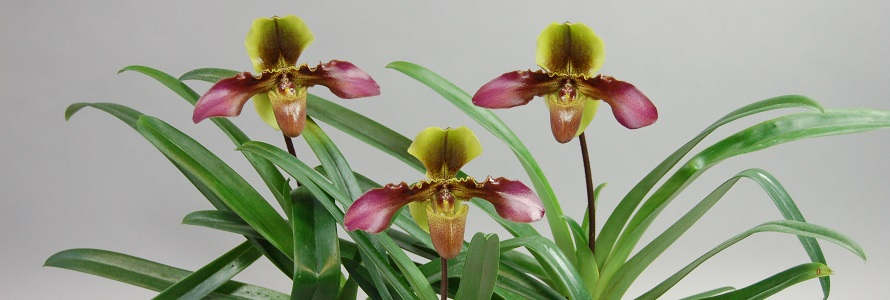
 ... to newsletter subscription
... to newsletter subscription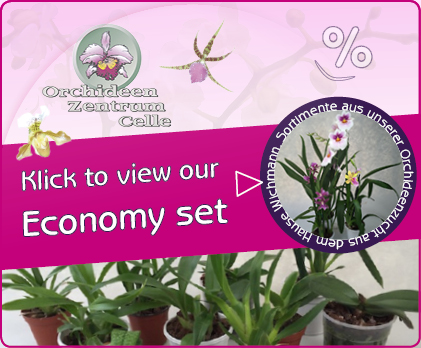 ... to see all economy sets
... to see all economy sets
